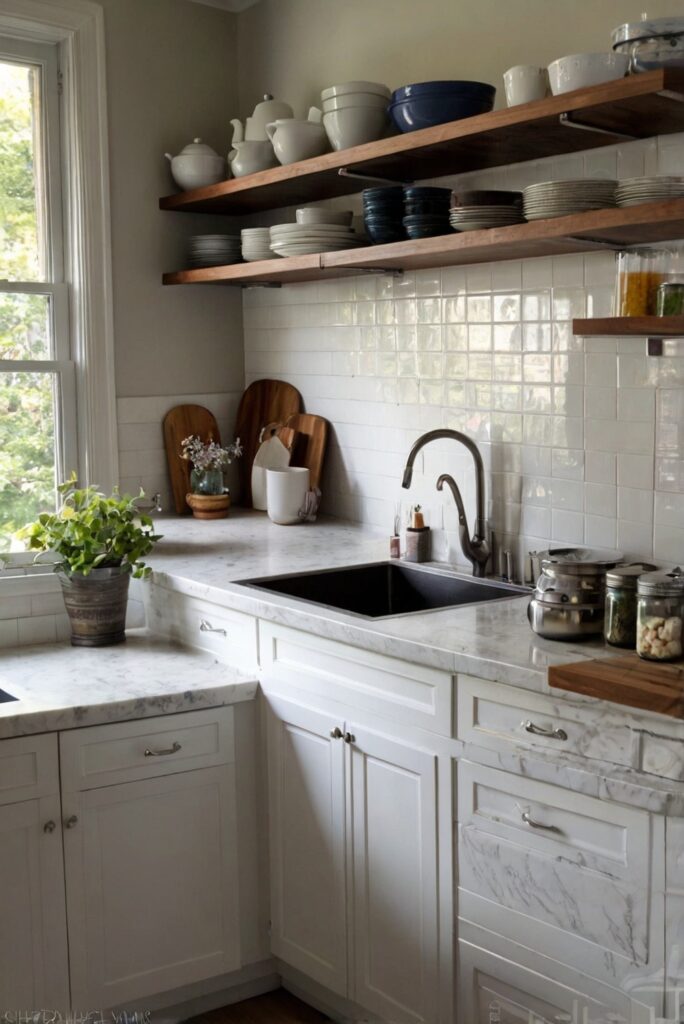Discover the advantages of open shelving and closed cabinets in kitchen design. From maximizing space to showcasing decor, explore the benefits of each in your interior designer routine.
The benefits of open shelving in kitchens include easy access to items, creating an open and airy feel, and showcasing decorative items. Closed cabinets offer hidden storage, protection from dust, and a cleaner appearance. To make the most of open shelving, organize items neatly, use matching containers for a cohesive look, and avoid overcrowding. Consider mixing open shelving with closed cabinets for a balanced look. For closed cabinets, choose pull-out drawers for easy access and adjustable shelves for versatile storage. Ultimately, the choice between open shelving and closed cabinets depends on your personal style and organizational preferences.
Benefits of Open Shelving versus Closed Cabinets in Kitchens
Open shelving and closed cabinets are two popular options for kitchen storage. Each has its own set of benefits and drawbacks. Here are some key advantages of open shelving compared to closed cabinets:
1. Visibility and Accessibility
One of the main benefits of open shelving is the easy visibility and accessibility it provides. With open shelves, you can see all your items at a glance without having to open and close cabinet doors. This can make it easier to find what you need quickly, especially for frequently used items.
2. Aesthetic Appeal
Open shelving can add a modern and airy feel to your kitchen. It creates an open and spacious look by allowing the walls to show through. You can also use open shelves to display decorative items or colorful dishes, adding a personalized touch to your kitchen decor.
3. Cost Savings
Open shelving is often more cost-effective than closed cabinets. Installing open shelves requires less material and labor compared to traditional cabinets, making it a budget-friendly option for those looking to save money on kitchen renovations.
4. Organization and Cleanliness
While open shelving has its advantages, closed cabinets also offer some benefits:
5. Concealment and Protection
Closed cabinets provide a concealed storage space, keeping your items hidden from view. This can be beneficial for those who prefer a clean and clutter-free look in their kitchen. Closed cabinets also offer protection from dust, grease, and other kitchen debris, helping to keep your dishes and cookware clean.
In conclusion, both open shelving and closed cabinets have their own unique advantages and disadvantages. The best choice for your kitchen will depend on your personal preferences, budget, and design aesthetic. Consider the benefits outlined above when making your decision to ensure that your kitchen storage meets your needs and enhances the overall look and functionality of your space.
Benefits of Open Shelving versus Closed Cabinets in Kitchens:
1. Accessibility:
Open shelving offers easy access to items, making it convenient to grab what you need quickly. Closed cabinets can sometimes lead to items being forgotten at the back and becoming inaccessible.
2. Aesthetics and Style:
Open shelving creates a visually open and airy feel in the kitchen, showcasing beautiful dishes and decor. Closed cabinets, on the other hand, provide a more streamlined and clutter-free look.
3. Space Perception:
Open shelving can make a kitchen appear larger by visually expanding the space, while closed cabinets can sometimes make a kitchen feel more enclosed.
4. Maintenance and Cleaning:
Open shelving requires regular dusting and organizing to maintain a tidy appearance, while closed cabinets can hide clutter and require less maintenance.
5. Organization and Storage:
Closed cabinets offer more concealed storage space, which can be beneficial for keeping items out of sight and maintaining a neater overall look. Open shelving, however, encourages organization and display of frequently used items.

